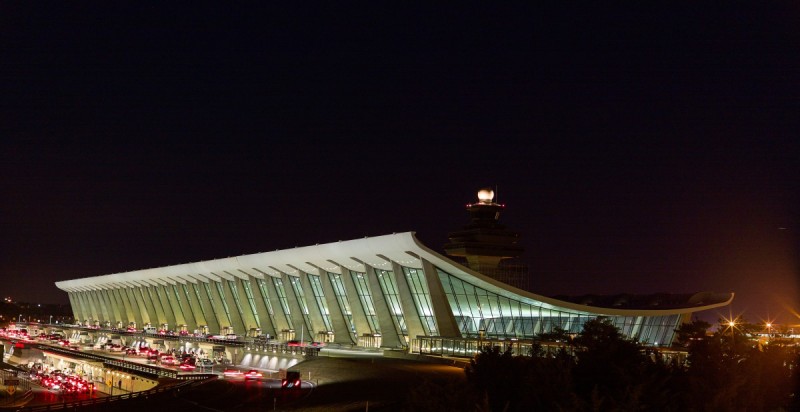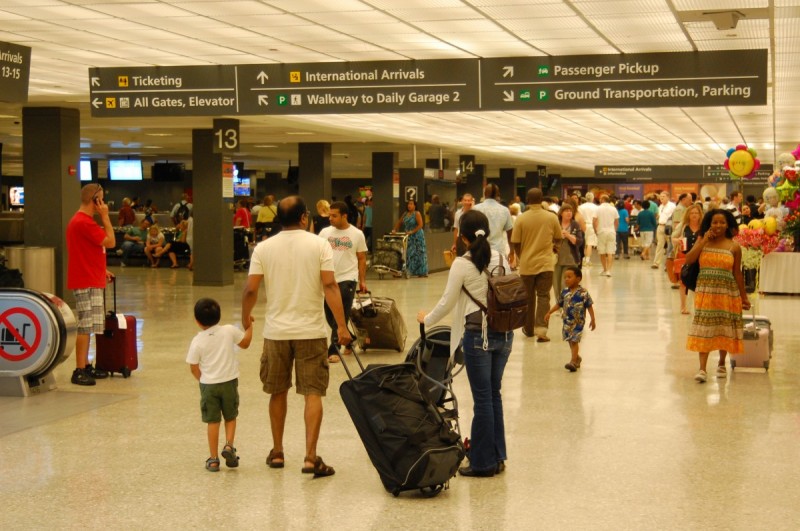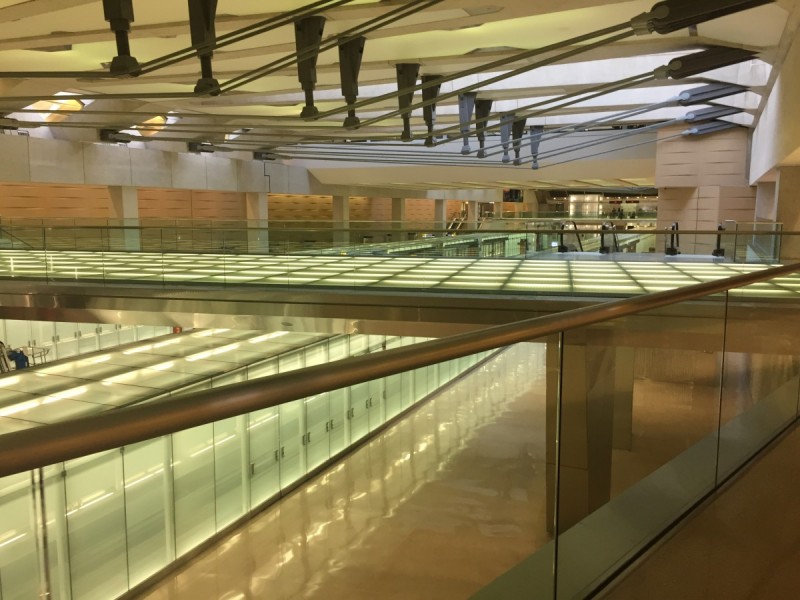Building of the Week: Dulles International Airport

The Washington Dulles International Airport main terminal at nighttime. Image by Andrew Griffith licensed under Creative Commons.
Three airports serve the DC area: Washington National, Washington Dulles, and BWI. The former two in particular have a number of interesting architectural features. A couple of months ago, GGWash Contributor Ned Russell took a look at National Airport’s Hangers 11 & 12. This building of the week is a more well-known aviation structure in the region – the Dulles Airport main terminal.
Although the airport may seem somewhat mundane to local residents, its main terminal is an iconic example of mid-century architecture in civil design. It was the first airport in the United States designed for commercial jet use, revolutionizing air travel.
Consequently, the airport used longer runways and (the now antiquated) mobile lounges to easily move passengers directly from the terminal to aircraft. Generally lamented by modern travelers, the mobile lounges were a game changer for their time. Like a sort of large bus, they transported passengers directly from the gate to the door of the plane without having to walk outside of the terminal.
One of Dulles Airport's mobile lounges. Image by paul_houle licensed under Creative Commons.
Washington National Airport had served the region since 1942, but by 1950, Congress was afraid that National was nearing its capacity. Congress consequently passed legislation to build a new regional airport in Virginia. Several locations were considered, including near modern-day Burke, or even Friendship Airport (today's BWI). Ultimately, President Eisenhower chose the current location of the airport 26 miles west of the District of Columbia, on top of the now-defunct, mostly black community of Willard. Construction began in 1958.
The vision for Dulles’ design lasted well into the future
Finnish-American architect Eero Saarinen designed the main terminal and the air traffic control tower. Saarinen is seen as a revolutionary figure in modern architecture in the United States, also designing the Gateway Arch in St. Louis and the iconic TWA Terminal at New York’s John F. Kennedy Airport.
Like most modernist architecture, Saarinen’s designs reflected the idea that form should reflect function. Unlike most of his contemporaries, however, Saarinen incorporated aesthetic curves into his work, departing from modernist orthodoxy.
Interior of the main terminal, near the ticketing area. Image by the author.
Although Saarinen died before Dulles was completed in 1962, his vision for the airport showed foresight for the future. As the airport’s traffic increased, the terminal’s length was increased in 1996 – all in accordance with Saarinen’s original design. Additionally, the airport authority chose not to incorporate large parking structures that would have obscured the terminal’s facade.
The main terminal from midfield. Mobile lounges and the Z Gates are visible. Image by the author.
Other elements of the terminal have aged less well. Although they were state-of-the-art in 1962, mobile passenger lounges soon became obsolete with the invention of jetways. Although the main terminal is still the starting point for all journeys originating from Dulles Airport, the airlines completed Concourses D and C (meant to be temporary) in 1985 and 1986, respectively, allowing passengers to reach aircraft without using the mobile lounges. The closer, permanent Concourses B and A were completed in 1998 and 1999, respectively.
The airport’s inter-concourse train system, AeroTrain, opened to the public in 2010, eliminating the need for most passengers to use the mobile lounges (transfers to the D Concourse and H Gates still use the lounges).
Impressions matter - Dulles is often the first thing that international travelers see when coming to the United States. Some parts of the airport, such as the arrivals area, have not aged as well as others. Image by Mark Levisay licensed under Creative Commons.
Dulles needs to stay modern, and the Silver Line is one attempt at that.
The Dulles terminal may be rooted in the jet age of the 20th Century, but the Metropolitan Washington Airports Authority plans to further modernize it. Like much of America’s aging infrastructure, Dulles is rooted in the era of suburbs and freeways. The Silver Line expansion to the airport is an attempt to keep it relevant for the modern era.
Although plans to provide rail service to the terminal have existed since the 1960s, today the role of the Silver Line is more existential – of the Washington region’s airports, Dulles sees the least passenger traffic despite being the largest. A cautionary parallel is Montreal, where the city’s far-flung Mirabel Airport failed to garner enough traffic to compete with the more convenient Dorval (now Trudeau) Airport. Dulles is even losing passengers to the even farther BWI Airport, primarily due to high enplanement costs.
The Aerotrain station is a newer addition to the main terminal as part of a plan to modernize the airport. Although it is not original to Saarinen's design, the station does incorporate a number of features such as bare concrete. Image by The West End licensed under Creative Commons.
Although the Silver Line extension will still bring passengers within view of the modernist façade of Saarinen’s masterpiece, the main terminal is increasingly just one component of the airport complex. The MWAA plans to build a new midfield concourse, a new runway, and a completed Aerotrain loop that would permanently eliminate the archaic mobile lounges.
The Dulles Terminal personifies a bygone era – a marvel of architectural achievement of its time, now struggling to maintain its relevance. My own experience transporting foreigners making their first trip to the United States from the airport, taught me that impressions matter – too many people find Dulles dingy and outdated. The airport undoubtedly needs some updates, but Saarinen’s contributions also have provided our region with a structure that is more than simply a place to fly in and out of.
